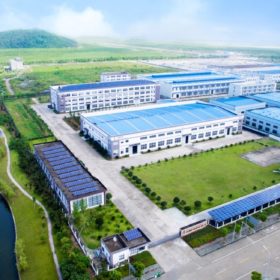
Chinese manufacturer Ginlong Solis‘ latest technology development, its fifth generation (5G) inverter, brings forward a new set of solutions for today’s smart energy infrastructure.
An inverter can be thought of as the ‘brain of the operation’ in a solar PV system, and as such, product selection has become more crucial than ever to address the increased complexity of today’s evolving energy infrastructure. “Our latest technology focuses on stability, safety and reliability of the grid interconnection as well as the safety of the data management to support power plants,” says Eric Zhang, sales director at Ginlong Solis.
“The PV inverter only accounts for 5% of the system cost, but is the whole core of the system,” Zhang adds. “The design of the device is no longer only about MPPT tracking and conversion efficiency.”
With the advancement of digitalization and AI, inverter manufacturers are stepping up their game in smart technologies to provide better services to solar PV system operation. The Ginlong 5G product is offering new features to meet customer and energy infrastructure demands.
1500 V technology application
For utility scale solar power plants, 1500 V systems have become a powerful weapon – and solutions for the higher voltage are becoming mainstream. By increasing DC side voltage, the new 5G inverter is able to deliver a new set of benefits.
- String sizing Construction costs can be brought down for large scale projects for 1500 V system. “The number of single-string components is increased by 50%, and the number of strings of photovoltaic sub-arrays is reduced by 33%,” says Zhang. This reduces the number of cables and brackets required on a job site.
- Cost reductions Increased voltage supports larger systems and reduces the number of transformers and inverters necessary for a project. This provides the opportunity to bring down costs for both construction, and O&M.
- Increased power generation AC/DC side cable loss is reduced with increased voltage to increase power output.
Double Optimized to Reduce Harmonic Content
Inverter harmonic content output from a grid-tied inverter impacts the power grid. “The control technology of the harmonic content of the inverter’s AC output is crucial,” says Zhang. Ginlong said it has optimized its hardware structure design along with algorithms to reduce the harmonic output to less than 1.5% for a single-phase inverter, and less than 2% for a three-phase inverter.
Expanding intelligence of the system
- Reducing overvoltage challenges Inverters can frequently be tripped, particularly in residential applications, due to excess voltage being on the grid. Frequent disconnections from the grid reduce the overall power generation of the PV system. Ginlong says that its new product will alleviate this challenge, with its ‘Volt-Watt mode’ using AI. If the grid voltage is unstable, the volt mode ensures that the PV system continues to produce electricity instead of shutting down. “This new feature can eliminate more than 80% overvoltage faults and effectively ensure continuous generation of the system,” says Zhang.
- Resonance suppression Ginlong says that another grid-friendly feature of its inverter’s hardware and software is its ability to suppress resonance. Multiple inverters are often used in parallel transmission with different resonance frequencies. This can result in grid interference and affect the grid’s stability and the operation of the PV system.
- Intelligent string monitoring and IV scanning Ginlong says that its new string IV curve scanning feature can quickly detect and alert service personnel of module faults, hot spots, and other challenges.
- PID detection The PID effect can hurt a PV system’s performance, “Power can drop sharply by up to 50% or even more, which has serious implications for continuous and efficient power output,” says Zhang. The company says it has anti-PID software placed into each inverter that recognizes the PID effect at the string level that can apply voltage to the PV string to help counter the PID effect. “The function of suppressing the attenuation of the photovoltaic module is achieved, so that the system can continuously and stably maximize the output,” Zhang adds.
- PWM Control Algorithm The new 5G inverters utilize a new bipolar PWM control algorithm which can reduce the change rate of the common-mode voltage, suppressing leakage current.”This new process can effectively reduce leakage current fault rates 50% to 60%,” says Zhang.
Ginlong says that its new 5G product has been developed with the intelligent technological upgrades to serve the transitioning energy system for 2020 and beyond. “The new innovative upgrades will ensure Solis customers experience even more of the efficient, reliable product performance that they have come to expect from Ginlong,” concluded Zhang.
Lắp đặt điện mặt trời Khải Minh Tech
https://ift.tt/2X7bF6x
0906633505
info.khaiminhtech@gmail.com
80/39 Trần Quang Diệu, Phường 14, Quận 3
Lắp đặt điện mặt trời Khải Minh Tech
https://ift.tt/2ZH4TRU
Không có nhận xét nào:
Đăng nhận xét